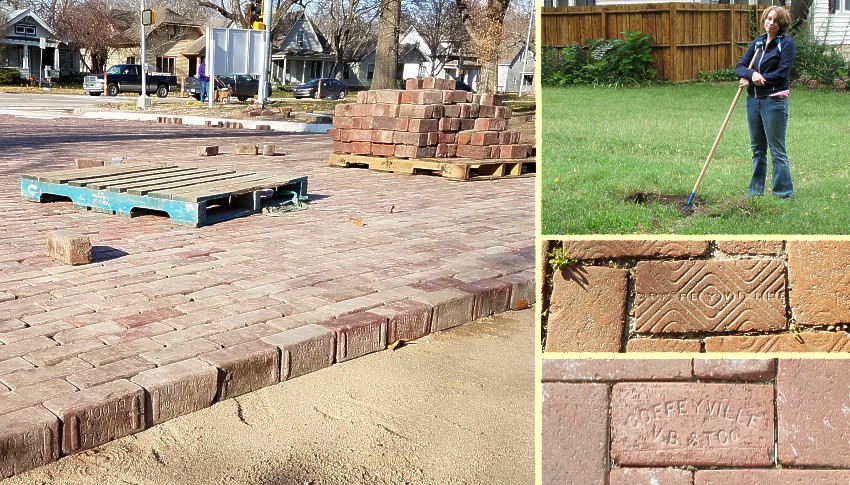Kansas Snapshots by Gloria Freeland - May 24, 2019
Walking on history
Husband Art and I have been walking 30 to 45 minutes every few days, and it has prompted us to learn a bit more about the history of
Manhattan, specifically about the city’s brick streets and sidewalks.
Sometimes such streets and walkways are referred to as being cobblestone, although strictly speaking, that is not correct. Cobble
originally referred to any rounded building stone approximately the size of a man’s hand. In the 19th century, these were used to build
durable streets and sidewalks with the stones kept in place with sand. A smoother surface was created by using uniformly-cut flat
stones, but the resulting surfaces were generally still referred to as cobblestone. This continued when cut stones were replaced by
manufactured bricks.
Manhattan’s Bluemont Avenue was once one of these brick-paved streets. Friend Jean lived in the 800 block as a young girl.
I remember the milkman delivering milk with his horse and cart. I can still hear the clop-clopping of the horse’s hooves on the
bricks. That street was beautiful. It was tree-lined and it was only two lanes.
Although Bluemont Avenue was covered with asphalt long ago, Juliette Avenue - which intersects Bluemont - was paved with bricks
in 1912 and is one of the few remaining brick roadways in Manhattan.
But recently, some of the bricks were breaking, while others had settled unevenly. In fall 2017, the city commission considered
how to repair it. Should they re-grade the street and replace the broken bricks or remove them and put in concrete? A Sept. 14,
2017 Mercury editorial reflected the feelings of area preservationists:
The rumble of bricks as you drive down Juliette Avenue is one of those nice, familiar Manhattan sounds. Brick streets are charming.
They’re historic. They’re also expensive ... But we think sometimes it’s worth spending a little more to preserve things, particularly
if they add something to the community ...
The decision was made to keep the bricks. In late 2017, crews began removing existing bricks and placing them on pallets before
laying a six-inch concrete base over rock and then covering the concrete with sand. The saved bricks were then reinstalled in the
main portions of the street, while intersections were paved with concrete because turning and stopping vehicles put additional
stress on the road surface.
We’ve watched the progress of the project with interest as daughter Mariya and her wife Miriam have a home nearby.
But since then, our attention has turned to Manhattan’s old brick sidewalks, which date back to the late 1880s, about 30 years after
the town was formed in 1855. Most of those sidewalks are in the older neighborhoods of Manhattan.
We own a home in one of those neighborhoods with a brick sidewalk in front. Although it’s not in terrible shape, the sidewalk could
use some care to remove grass that has taken over along its edges. One year when Mariya was living in the upstairs apartment of the
home, we had her and her sister Katie help remove grass and weeds, take up the bricks, level the ground and re-set the bricks.
Another year, Katie spent hours cleaning the encroaching dirt and grass. It would have been easier to lay a concrete sidewalk as a
neighbor had, but we felt we’d be losing a part of our history.
Because bricks are so heavy, transporting them over great distances is expensive. This prompted many communities to establish their
own brick-making operations. Manhattan had several in the late 1800s.
One was J.M. Drown, who advertised in the January 1893 Manhattan Homestead: “Makes red brick at his brickyard. Employs four men in
season. Has good facilities. Carefully selects ground in order to make best bricks.”
The Manhattan Nationalist of Sept. 20, 1900 had the following: “One hundred feet of vitrified sidewalk will soon be laid in front of
A. E. Bailey’s livery barn and residence on East Poyntz Avenue.”
Vitrification refers to raising the temperature of the brick during manufacture to the point where the surface melts, so when cooled,
water will not penetrate.
In 1901, E.H. Davies wanted a brick walk and canvassed his neighbors, saying he’d lay all the brick free if they would supply the
materials. He reportedly bought stock in a brick company in Coffeyville, Kansas. In the next 10-12 years, he laid 25 miles of brick
walks.
In 1909, a brick sidewalk was laid on the north side of Bluemont Avenue with a wide strip for parking along with a double row of
trees. The following year, a brick factory was to open on the south side of the Kansas River Bridge with several kilns for making
10,000-20,000 bricks daily.
Bricks from Coffeyville, Independence, Humboldt and Buffalo - other Kansas towns - were also used in Manhattan sidewalks and streets.
Art and I have noticed a proliferation of the Coffeyville bricks - some with just the name of the town and some with “Coffeyville VB
& T Co.” (Coffeyville Vitrified Brick & Tile Co.) on them. When Juliette was being repaired, we also saw pallets of bricks made in
Buffalo, in southeast Kansas. At one time, the Buffalo brick factory, which opened in 1903, was the largest one west of the
Mississippi River.
Each year in May, local preservation groups, state historical societies, and business and civic organizations across the country
participate in Preservation Month. Events promote the social and economic benefits of preserving historic places and celebrate the
diverse and unique heritage of the country’s cities and states. Members of the Manhattan/Riley County Preservation Alliance believe
these old sidewalks are important and so in May 2007, they added them to the list of endangered cultural resources of the city.
For us, it was fun to learn a bit about the history of brick paving and it also prompted us to once again spruce up our sidewalk so
we and others can enjoy walking on history.
